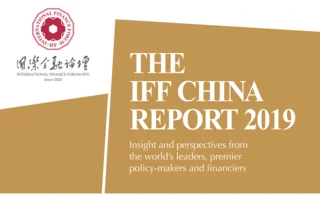
Fintech and the future – Improving financial literacy
Former PBoC deputy Li Dongrong explains how financial technology can aid sustainable growth


Recent advances in technological innovation have led to improved attitudes and an interest in how technology can aid the regulation and supervision of financial markets, as opposed to the present focus on improving financial competition, co‑operation and inclusion.
Positive development
Financial technology – or fintech – is transforming the structure of the financial market by facilitating the emergence of non-bank players and has had the following impact on financial markets:

1. Accelerating the transformation of the global financial industry. Financial development has always gone hand in hand with financial innovation. For example, the invention of smelting, papermaking and printing technology resulted in new methods of creating and distributing currency. Developments in communication, such as the invention of the telephone and telegraph, enabled finance to reach out to different classes more quickly. In the second half of the 20th century, the development of the computer – and later the internet – fundamentally altered the structure of the finance industry, resulting in automated
and digital banking. Today, with technological development reaching unprecedented speeds, artificial intelligence, cloud computing, big data, blockchain and other modern information technologies have come to the fore. These inventions offer the industry a rare historical opportunity to evolve once more – this time into a network-based, digital and intelligent system.
2. Promoting global inclusivity. Financial inclusion initiatives have made great strides over time, promoting financial markets in many developing economies. Traditionally, some forms of finance are costly, unsustainable and inefficient for less developed markets. The World Bank calculates that around 1.7 billion people worldwide do not have a bank account, while more than 65 million micro, small and medium-sized enterprises in developing countries are suffering a finance gap of US$5.2 trillion in credit. But change is beginning to occur, and technology is bridging the gap. In countries such as China and Kenya, financial inclusion strategies have drastically reduced the number of people without access to banking services by leveraging technology to cut costs and widen the gamut of financial services.
3. Sustainable growth. Fintech also has the potential to aid sustainable growth. As more and more financial firms witness the benefit of technological innovation, the volume of investment into research and development (R&D) increases. Risk, as a result, is reduced as more labour and resources are directed towards technological development. In this respect, fintech has the potential to co‑ordinate development in financial markets and across wider industries.
New governance challenges
The fintech sector is still maturing, and lingering financial governance challenges remain. One such challenge is the ‘digital gap’. In the financial industry of every country, levels of technical development infrastructure, education and investment vary widely; in many countries contactless mobile payments are possible, whereas in others the nearest cash machine may be a walk of several miles away. According to the World Bank, 2 billion people do not own a mobile phone and nearly 60% of the population remains without access to the internet. This gap in digital access and understanding will limit how many people can benefit from this fintech revolution.
The second challenge is regulatory arbitrage. In some countries, a ‘race to the bottom’ occurs following policies that over-prioritise financial development. Regulatory trends around fintech tend to see new products or firms domicile themselves in less strictly regulated countries, or at least in countries more ‘friendly’ towards new entrants. If these products and services are to be made global, this issue needs to be monitored closely.
The third challenge arises if technological risk becomes ‘contagious’. Given the openness and growing interconnectedness of financial markets, risks that evolve from technological advancement have a greater chance of leeching into other sectors of the economy.
Healthy and co‑operative development
There are always two sides to development, and equal attention should be paid both to the risks and the benefits fintech has to offer. This new form of innovation should be approached with a positive attitude, but also with prudence. Only in this way can we truly seek to profit and avoid harm, and fully realise the socioeconomic value of fintech in a more secure way.
International consensus
After almost a decade of observation and in-depth discussions, the international community is starting to form a consensus on fintech. First, it should serve the development of the real economy, and improve the quality of financial services and the level of inclusiveness across the globe; it should integrate small and micro enterprises into the wider economy, while allowing people from all backgrounds to access financial services. Fintech should enhance consumer protection and improve financial literacy in a sustainable fashion. The financial industry is a long-cycle industry, and fintech must stay relevant over time and evolve in tandem with the broader sector without introducing unnecessary risks.
Characteristic development
Currently, there is no ‘best practice’ model for fintech. To judge by early experiences, every country should define its own principles around how it wants to utilise new technology. For example, in the absence of a high-speed mobile network, Kenya developed its own around a mobile messaging service that would allow money transfers. China has made full use of the advantages of the size of its market when it comes to tech, carrying out many initiatives in its own mobile money network. In the UK and Singapore, among other countries, there has been an increased focus on creating a welcome regulatory environment for fintech.
Stronger international regulatory co‑ordination
China should make full use of existing international organisations such as the World Bank and the International Monetary Fund (IMF) to strengthen the assessment and risk monitoring of fintech developments and tackle cross-border challenges. At the same time, China should establish a mechanism for regulatory information sharing and an ‘early warning system’ to continuously improve cross-border supervisory capacity. In October 2018, the World Bank and the IMF developed the Bali Fintech Agenda, which examined the opportunities and potential risks posed by fintech and tendered many promising suggestions.
Domestically, co‑operation is also vital. Forums, training and peer learning should be explored by government, industry and academia. Qualified institutions in each country are encouraged to broaden efforts in initiatives such as joint laboratories and co‑operative R&D centres.
International standards
Nothing can be accomplished without standards. Under the aegis of the International Organization for Standardization and other international bodies, multiple standards apply, but there is no consensus. Three key topics – financial infrastructure connectivity, consumer protection, and fintech risk prevention and management – can act as building blocks toward a one-stop shop set of regulations.
Fintech holds promise, and financial markets are aware of this. The industry must now unite to ensure the sector matures in a controlled but innovative manner – one that can support the world economy, encourage financial inclusion, and spur growth.
Only users who have a paid subscription or are part of a corporate subscription are able to print or copy content.
To access these options, along with all other subscription benefits, please contact info@centralbanking.com or view our subscription options here: http://subscriptions.centralbanking.com/subscribe
You are currently unable to print this content. Please contact info@centralbanking.com to find out more.
You are currently unable to copy this content. Please contact info@centralbanking.com to find out more.
Copyright Infopro Digital Limited. All rights reserved.
As outlined in our terms and conditions, https://www.infopro-digital.com/terms-and-conditions/subscriptions/ (point 2.4), printing is limited to a single copy.
If you would like to purchase additional rights please email info@centralbanking.com
Copyright Infopro Digital Limited. All rights reserved.
You may share this content using our article tools. As outlined in our terms and conditions, https://www.infopro-digital.com/terms-and-conditions/subscriptions/ (clause 2.4), an Authorised User may only make one copy of the materials for their own personal use. You must also comply with the restrictions in clause 2.5.
If you would like to purchase additional rights please email info@centralbanking.com







